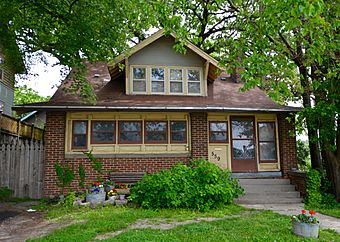Ingersoll Place Plat Historic District facts for kids
Quick facts for kids |
|
|
Ingersoll Place Plat Historic District
|
|

559 28th Street
|
|
| Location | 28th, Linden, and High Sts., Des Moines, Iowa |
|---|---|
| Area | 7.76 acres (3.14 ha) |
| Architect | Charles Dombach |
| Architectural style | Colonial Revival |
| NRHP reference No. | 00000931 |
| Added to NRHP | November 21, 2000 |
The Ingersoll Place Plat Historic District is a special area in Des Moines, Iowa, United States. It's known for its unique houses and history. This district was added to the National Register of Historic Places in the year 2000. It's important because it has many bungalows and square-shaped houses.
Contents
Discovering Ingersoll Place's Past
The Ingersoll Place Plat was officially created on September 27, 1906. This happened thanks to the Des Moines Life Insurance Company. Around the same time, a big sewer line was built. This line was about 21,460 feet (6,541 meters) long. It brought sewer service to the northwest part of Des Moines.
Early Neighborhood Growth
Homes first started appearing near Ingersoll Park. This was a fun amusement park located at 42nd Street and Ingersoll. The park closed in 1911. After that, house building moved east from the park. This was a bit unusual for Des Moines. Usually, new developments spread from east to west.
Why People Moved Here
The area was also popular because of a streetcar line. This streetcar had been running on Ingersoll Avenue since 1897. It made it easy for people to travel around the city. This made the area a great place to build new homes.
Building Challenges
However, there was a money problem called the Financial Panic of 1905-1906. This slowed down construction. Fifty of the building lots could not be sold at first. They had to be sold again later.
Exploring Ingersoll Place Architecture
The Ingersoll Place Historic District has many interesting types of houses. Most of the houses, about twenty-four of them, have a square shape. These are often called "square houses."
Different Roof Styles
You can see different roof styles in the district. Thirteen houses have a front gable roof. This means the triangular part of the roof faces the front. Eight houses have hipped roofs, which slope down on all four sides. Three houses have side gables, where the triangular part faces the side. The houses with hipped roofs are mostly on the east side. The front-gabled houses are found on the west side.
Bungalow Homes
The district also has several bungalows. Five bungalows have front gables. Most of these are on Linden Street. Some bungalows have a hipped roof. Others have a double gable on the front. Two more bungalows have a gable front with a gabled side porch.
Five other bungalows have side gables. Three are on Linden Street, and one each is on High and 28th Streets. Some of these have a single roof slope and a porch across the whole front. Others have a single roof slope but a smaller front porch. There is also one house with a double main roof slope. It mixes styles like American Craftsman and Classical Revival.
Other Unique Houses
Seven houses in the district are not bungalows or square houses. Two houses are a common type in Des Moines. They are a side-gable, story-and-a-half square house. Two houses are built in the Colonial Revival style. One house is Neoclassical and another is Prairie School style. One large house on High Street has a unique design that doesn't fit a specific style. The district also includes thirteen detached garages. These garages are also considered important historical properties.
Important Buildings



